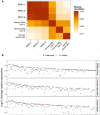Beta cell 5'-shifted isomiRs are candidate regulatory hubs in type 2 diabetes
- PMID: 24039891
- PMCID: PMC3767796
- DOI: 10.1371/journal.pone.0073240
Beta cell 5'-shifted isomiRs are candidate regulatory hubs in type 2 diabetes
Abstract
Next-generation deep sequencing of small RNAs has unveiled the complexity of the microRNA (miRNA) transcriptome, which is in large part due to the diversity of miRNA sequence variants ("isomiRs"). Changes to a miRNA's seed sequence (nucleotides 2-8), including shifted start positions, can redirect targeting to a dramatically different set of RNAs and alter biological function. We performed deep sequencing of small RNA from mouse insulinoma (MIN6) cells (widely used as a surrogate for the study of pancreatic beta cells) and developed a bioinformatic analysis pipeline to profile isomiR diversity. Additionally, we applied the pipeline to recently published small RNA-seq data from primary human beta cells and whole islets and compared the miRNA profiles with that of MIN6. We found that: (1) the miRNA expression profile in MIN6 cells is highly correlated with those of primary human beta cells and whole islets; (2) miRNA loci can generate multiple highly expressed isomiRs with different 5'-start positions (5'-isomiRs); (3) isomiRs with shifted start positions (5'-shifted isomiRs) are highly expressed, and can be as abundant as their unshifted counterparts (5'-reference miRNAs). Finally, we identified 10 beta cell miRNA families as candidate regulatory hubs in a type 2 diabetes (T2D) gene network. The most significant candidate hub was miR-29, which we demonstrated regulates the mRNA levels of several genes critical to beta cell function and implicated in T2D. Three of the candidate miRNA hubs were novel 5'-shifted isomiRs: miR-375+1, miR-375-1 and miR-183-5p+1. We showed by in silico target prediction and in vitro transfection studies that both miR-375+1 and miR-375-1 are likely to target an overlapping, but distinct suite of beta cell genes compared to canonical miR-375. In summary, this study characterizes the isomiR profile in beta cells for the first time, and also highlights the potential functional relevance of 5'-shifted isomiRs to T2D.
Conflict of interest statement
Figures





References
-
- Kim VN (2005) MicroRNA biogenesis: coordinated cropping and dicing. Nat Rev Mol Cell Biol 6: 376–385 doi:10.1038/nrm1644 - DOI - PubMed
-
- Kim VN, Han J, Siomi MC (2009) Biogenesis of small RNAs in animals. Nat Rev Mol Cell Biol 10: 126–139 doi:10.1038/nrm2632 - DOI - PubMed
-
- Bartel DP (2009) MicroRNAs: target recognition and regulatory functions. Cell 136: 215–233 doi:10.1016/j.cell.2009.01.002 - DOI - PMC - PubMed
-
- Bartel DP (2004) MicroRNAs: genomics, biogenesis, mechanism, and function. Cell 116: 281–297. - PubMed
-
- Hudder A, Novak RF (2008) miRNAs: effectors of environmental influences on gene expression and disease. Toxicol Sci 103: 228–240 doi:10.1093/toxsci/kfn033 - DOI - PMC - PubMed
Publication types
MeSH terms
Substances
Grants and funding
LinkOut - more resources
Full Text Sources
Other Literature Sources
Medical
Molecular Biology Databases

